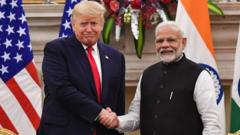As the deadline looms, the prospects of a significant trade deal hang in the balance amid tough negotiations.
**Is the India-US Trade Agreement Facing Challenges?**

**Is the India-US Trade Agreement Facing Challenges?**
A critical analysis of the complexities in the ongoing negotiations between India and the United States.
With just a few days left leading up to the July 9 deadline set by the Trump administration, the anticipated India-US trade deal faces a labyrinth of challenges. Despite comments from White House Press Secretary Karoline Leavitt suggesting an imminent agreement and Indian Finance Minister Nirmala Sitharaman’s optimistic remarks about a "big, good, beautiful" deal, negotiations have entered a crucial phase marked by contentious discussions.
Key obstacles remain, particularly around agricultural access, tariffs on auto components, and Indian steel imports. Indian trade officials have extended their stay in Washington, signaling a commitment to continue negotiations, even as India stands firm on its "very big red lines," particularly concerning farm and dairy protections. With the negotiation window narrowing, Ajay Srivastava, former Indian trade official and head of the Global Trade Research Initiative (GTRI), underscores that the next seven days are critical in determining if a limited "mini-deal" is on the table or if negotiations will stall.
A prime point of contention is agricultural access, which has been a significant barrier in talks. The U.S. is seeking greater access to the Indian market for basic agricultural products, a move India is reluctant to accept due to concerns over food security and the livelihoods of millions of small farmers. Richard Rossow from the Center for Strategic and International Studies highlights that the growing framework of India's Quality Control Orders (QCO) could complicate U.S. market access and hinder progress in trade discussions.
Farm trade between India and the U.S. has been limited, with total exchanges valued at just $8 billion. While India currently exports products like rice and shrimp, the U.S. is keen on expanding its agricultural exports of corn, soybeans, and cotton, thereby attempting to reduce its $45 billion trade deficit with India. Concerns have been raised that any tariff concessions demanded by the U.S. could lead India to compromise its minimum support prices (MSP), essential for protecting farmers from volatile market conditions.
Despite the challenges, a recent recommendation from Niti Aayog suggests potential tariff cuts for U.S. farm imports such as rice, dairy, and corn, raising questions about whether such suggestions reflect formal policy or remain speculative. The negotiations are hyper-sensitive politically, as the Indian government faces considerable internal pressure.
If the deal ultimately fails, experts predict that Trump is unlikely to reinstate tariffs on India. Historically, tariffs have been applied selectively to 57 countries, with only the UK successfully securing a deal. However, the unpredictability of Trump's administration heightens the stakes.
As negotiations inch forward, tentative discussions about a "mini-deal" could allow India to reduce tariffs on industrial goods while granting limited agricultural concessions. In turn, the U.S. might seek significant commercial purchases, easing foreign direct investment (FDI) restrictions, which would benefit companies like Amazon and Walmart.
In summary, the trade talks, which initially held promise under the leadership of Trump and Modi, now face an uncertain future filled with complicated barriers on both sides. Enhanced dialogues could pave the way for a more manageable agreement, but whether negotiators can bridge their differences in time remains to be seen.





















